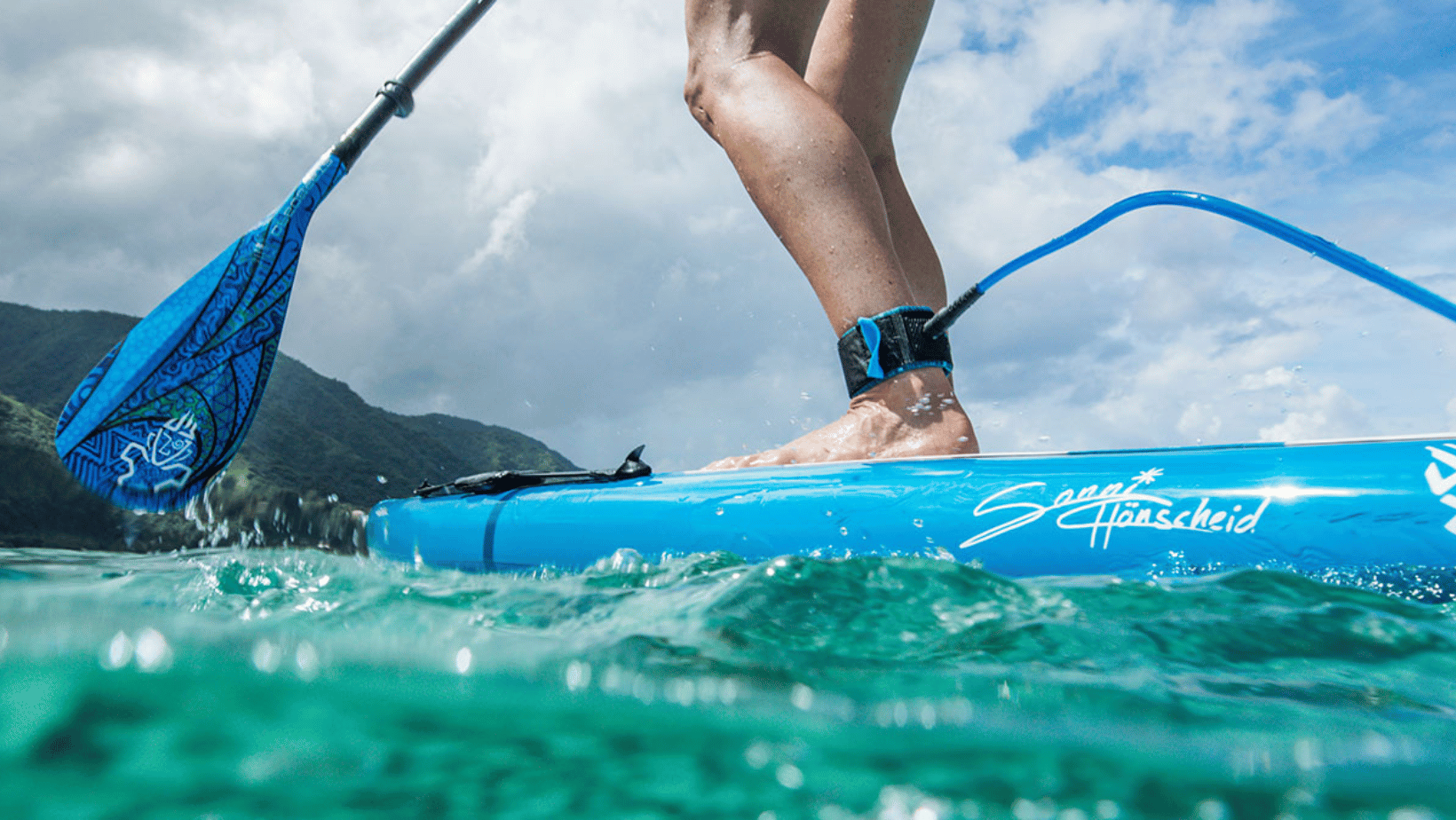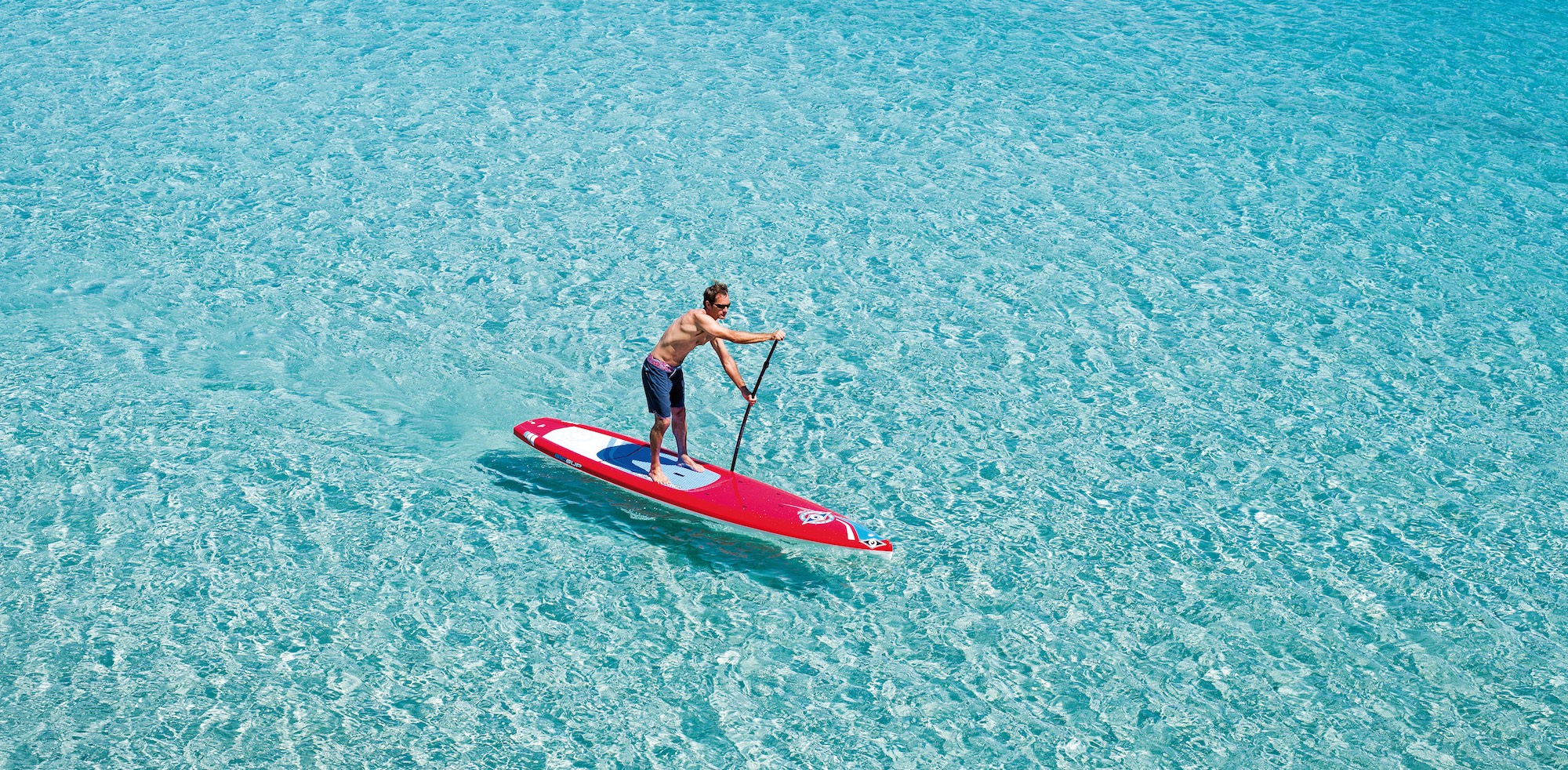We use cookies to ensure you get the best experience on our website. More Info.
HOW TO CHOOSE A SUP

Would you like to buy a SUP (stand Up Paddle board) but you don't know whick one? Sportmania will help you choose according to your weight, your level, your program and your storage possibilities. Read more here or call us at 021 550 0850 for personalised advices or read below to get an idea.
What is a Stand Up Paddle?
Stand up paddle (SUP) is a water sport where the rider is standing on a longer and wider than a conventional surfboard, and propelling it with a paddle. This sport was born in 1960 in Hawaii, but was quickly overwhelmed by the arrival of short boards. He returned to the front of the stage during a competition in Hawaii , organized in 2004.
Which are the parameters to choose a SUP?
To avoid ending up with inadequate board you will have to choose a board that is the best for your weight, your level, your program, your storage possibilities.
a) Here is our advices to help you choose according to your weight:
1) To keep stability: the choice of the volume and width of your SUP depend on your weight. The higher it is, the greater the volume and width.
2) Beware of excess: a small rider will struggle to paddle in a board too wide for him. Furthermore a SUP too large may be too heavy / bulky.
3) If you are looking for a SUP to be used by more people, better opt for a larger model: a small rider can always use a big board, but the reverse is not true.
4) The thickness of an inflatable is even more important than all the other dimensions (length and width) as it not only has an effect on the water but also the rigidity - everyone needs and wants his paddle be as rigid as possible. The thicker boards are more rigid, but too thick construction reduces responsiveness.
The RSS (Rocker stiffing System) by Red Paddle SUP allowa to increase rigidity by up to 40%. It works by inserting stiffening battens along the rails of the board. The battens then work against the downward force of the rider to produce a stiffer board by preventing flex. The stiffening strips are removable for easy board rolling and can be stored in the carry bag for transportation to and from the water.
Eg a board of 100mm with RSS has the same rigidity as a SUP of 120 mm but a maneuverability of a 100mm.
b) Here is our advice to help you choose according to your level and program:
There are 6 major categories of SUP boards: wave (or surfing), allround, touring, race, windsurfing and yoga.
1) Wave-Surf: boards specifically for surfing are often short, show a nose and a tail (rear) narrower and more rocker (curve). These characteristics make them more manageable in the waves, but also slower and less directional on the flat. They are also less stable.

2) All-round: These versatile models are designed to sail in all conditions. They are suitable for beginners, because they can discover all the activities of the SUP on a single board. They have enough width for good stability, a good level of gliding and good directivity in flat water or at sea. Their rocker generally allows good surfing performance.
3) Touring:These boards are designed for long rides on flat water and the sea downwind (downwind). They are generally wide enough (for stability) and long for more speed and steering. Their front is often pointed and features a V-shaped hull in front to slide right and do not type in choppy face. Relatively stable, these boards can be used by beginners

4) Windsurfing (windsup):This is an option that is found on some boards allround equipped with a mast foot built into the board. This makes it the perfect board for those that want windsurging when the wind is there or paddle on flat water.

5) Race :The race boards are primarily designed to go fast with the basic idea: if a SUP is long, the more it slips over, the more it goes fast. Race SUPs have standard lengths of 12'6 or 14 '(14 feet)
In competition, the 12'6 is the most common class. So if you want to align yourself with the races, it's the best choice.
The more a SUP race is narrow the more it goes quickly (because less surface), but it is less stable.
▪ Too narrow: A rider in constant search of balance or that falls will be slower than a riders well anchored on his board
▪ Too wide: A practitioner who never falls has very likely a too wide board.

6) Yoga: SUP yoga are stand up paddle boards for those who want to combine pure stand up paddling fun with fitness and yoga workouts. These boards are normally larger, more stable and equipped with elastic system. SUP Yoga will help to maintain the balance and postures on fluid water such as the ocean or a lake.

C) Stand up paddle rigid or inflatable?
Storage and transport: Inflatable advantage
This is the very strong point for inflatable SUP: Deflated, the board fits in a backpack. In addition, inflatable SUP are generally sold with a adjustable or detachable paddle.
Well of course it's a big backpack but:
▪ You can put 4 in the trunk of your car
▪ If you do not have a garage, it will be easier find a place at home
▪ Perfect for going on a trip by boat or plane without any issue.
Of course, if you have a double garage, as you drive in extended van and you live 5 minutes from a lake or see, this is not a criterion.
Robustness: Inflatable advantage
Inflatable SUP are much more resistant than rigid board especially on impact and crushing. No stress if you lend to your kids. Whatch this video about the robustness of a Red Paddle board:
By means against air burstable. Beware of thorns, hooks, knives or other sharp objects. You may prefer a rigid SUP to go fishing.
If we do not necessarily realize that we have taken a pet taking in water on a rigid SUP, you quickly realize that your inflatable SUP is punctured: Inflatable advantage.
Versatility and performance: Rigid SUP advantage
Although the inflatable SUP market is booming and that almost all the SUP brands now offer inflatable model, diversity of supply remains poor.
Construction techniques of inflatable SUP significantly limit the design of the boards.
Designers can only choose a length and slightly modulate the outline (online view) and rocker (line side view).
Unlike the rigid SUP are constructed from polystyrene bread that can be sculpted in great detail. This allows all the possibilities one end of the hull work, the rails of the outline, rocker, deck ...
In short, the possibilities are incomparable and performance on arrival too.
Management fins Rigid advantage
All have removable rigid SUP fins that can be adjusted and / or changed the board to change the behavior. (Which is an advantage)
The side airbags are located in 2 schools: the indestructible approach with flexible and fixed fins (that is perfect for the river and children) and the performance approach with removable rigid fins. (You will have to be careful at this point according to its program at the time of purchase)
